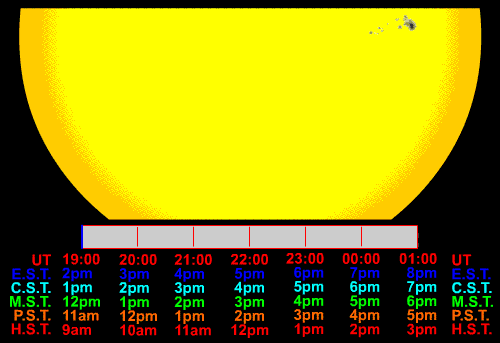Welcome to
| Wednesday's 1:00 November 8th, 2006 Duffer Lunch will be at The Nicks in Lemont. The planet Mercury will begin a 5 hour transit of the Sun while the Duffers are having lunch. If the Sky is clear, I will be at a Steeple Run school in Naperville with my Solar Telescope. Come on out! |
Our Post Game festivities are at Buffalo Wild Wings every Friday Night.
Rich Storm strikes again!
Ken's 1 day old Granddaughter Carmela
| 22 years ago, my Son Ken and wife Kim had a son (Michael) that
made my Mom a great Grandmother and Carole and me became Grandparents.
October 25, 2006 at 3:21 A.M. My grandson Mike and Trina made us great
grandparents with the birth of their daughter, Carmela Marie. My
93 year old Mom is now a Great Great Grandmother!
Carmela was born at 3:21 A.M. (8:21 Universal Time) She weighed in at 3,515.34 grams that sounds like a lot, but it is just 3.52 kilograms or (7 lbs 12ounces) She is 46.99 centimeters or .47 meters (18 1/2 inches long) For pictures of Carmela Marie, click on Carmela's first day |
Try this Quail Hunting School, but don't have any beers or you will shoot a lawyer.
 |
|||||||||||||||||||||||||||||||
 |
|||||||||||||||||||||||||||||||
|
|||||||||||||||||||||||||||||||
 |
|||||||||||||||||||||||||||||||
|
|
|||||||||||||||||||||||||||||||
 |
|||||||||||||||||||||||||||||||
|
|
||||||||||||||||||||||||||||||
|
|||||||||||||||||||||||||||||||
|
|||||||||||||||||||||||||||||||
|
|||||||||||||||||||||||||||||||
 |
|
||||||||||||||||||||||||||||||

|
|||||||||||||||||||||||||||||||
 |
|||||||||||||||||||||||||||||||
 |
|||||||||||||||||||||||||||||||
|
|||||||||||||||||||||||||||||||
Click on the pictures to see the full size image, then use your browser's back button to return to this page.
|
To E-mail the Duffer News Web master, just click here! g.lopatka@comcast.net You can e-mail History updates to Beak.
|
|
http://www.sportzdomain.com/womenshockey/
http://www.coloradoavalanche.com/
Looking for a page with your name on it? Try
the
|
|
November 3rd, 2006 http://www.lopatka.net/11-03-06/index.htm
October 27th, 2006 http://www.lopatka.net/10-27-06/index.htm
October 20th, 2006 http://www.lopatka.net/10-20-06/index.htm
October 13th, 2006 http://www.lopatka.net/10-13-06/index.htm
Caught Red Handed! |
|||
|
|
Mark your calendar: On Wednesday, Nov 8th, the planet Mercury will pass directly in front the Sun. The transit begins at 1:12 pm CST and lasts for almost five hours. Good views can be had from the Americas, Hawaii, Australia and all along the Pacific Rim: visibility map.
What will it look like? A picture is worth a thousand words:

Image credit: Larry
Koehn. Click to view the Sun's full disk.
During the transit, Mercury's tiny diskójet black and perfectly roundówill glide slowly across the face of the Sun. Only a speck of the Sun's surface is actually covered, so the Sun remains as dangerous as ever to look at. But with a proper filter and a little imagination, the Transit of Mercury can be a marvelous experience.
There are many ways to safely observe the Sun, e.g., through eclipse glasses or by means of a pinhole projector. In this case, nothing beats a telescope equipped with a sun-safe H-alpha filter. H-alpha filters are narrowly tuned to the red glow of solar hydrogen. They reveal the Sun as a boiling inferno, cross-crossed by dark magnetic filaments and peppered with sunspots. Warning: The sight of Mercury navigating this starscape could be mind blowing.
Teachers, call your local astronomy club and ask if they have such a solar telescope. Amateur astronomers love to show off the heavens, and someone will probably volunteer to bring their 'scope to your classroom for the transit. (You can also view the transit online at the SOHO web site--no telescope required.)
 Right:
Mercury, photographed by Mariner 10. [More]
Right:
Mercury, photographed by Mariner 10. [More]
Here's something to think about while watching the transit: Mercury is fantastically mysterious. More than half of the planet is unknown to us. When Mariner 10 flew by in the mid-70s, it managed to photograph only 45% of Mercury's cratered surface. What lies on the other side? More craters? Or something totally unexpected? You're free to speculate, because the next spacecraft to visit Mercury, NASA's MESSENGER probe, won't enter orbit until 2011.
One of Mercury's greatest secrets is the mystery-material at its poles. Radars on Earth have pinged Mercury and received a strong echo from polar craters. A favorite explanation is ice. While Mercury's daylit surface heats up to 400o C, the temperature in deep, dark polar craters dips below -200o C. If an icy comet landed in one of those craters (or made one of those craters), the comet's ices, vaporized by impact, might re-freeze and stick around. As skeptics like to say, however, "it's just a theory," one of many that MESSENGER will check.
Another puzzle is Mercury's wrinkles. Geologists call them "lobate scarps." Like wrinkles on a raisin, the scarps are thought to be a sign of shrinkage. Mercury may actually be collapsing in on itself as its massive iron core cools and contracts. To check this idea, MESSENGER will map Mercury's magnetic field, which springs from the core. If the core is collapsing, the collapse may leave telltale signs in the planet's magnetism. MESSENGER will also look for lobate scarps on the uncharted side of Mercury to see if this is truly a global phenomenon.
The answers are years away. Meanwhile, we watch and wonder, and Nov. 8th is a good day for that.